– Medici are expelled in 1494
– da big 3: Leonardo Da Vinci, Raphael, Michelangelo
– calmness, beauty, perfection, humanism, grandness, grace, elegance
– Humanism
– Grunewald
– Pieter Bruegel
– detail, large landscapes
– oil paints
– elongated figures, unbalanced, complicated
– reaction against High Renaissance
1623-1650
Bernini
– master at a very young age
vs.
Borromini
– OVALS, convex/concave, majestic, overwhelming, shadows
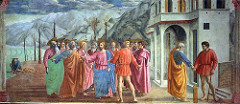
Massacio
c. 1425
Brancacci Chapel, Florence
fresco
– 3 scenes in 1; tax collector demanding tax/Peter being told by Jesus to get fish (in center), Peter getting the money from fish’s mouth (left), Peter talking to tax collector (right)
– orthogonals meet at Jesus’ head
– the tax collector is dressed in different clothes

Fra Angelico
1438-45
San Marco Convent, Florence
fresco
– Dominican monastic cloister; simple painting, simple life
– architecture of painting echos architecture of cloister
– angel Gabriel’s wing actually gleam when caught by light
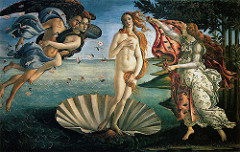 divine beauty, neoplatonic ideas” alt=””Birth of Venus”
divine beauty, neoplatonic ideas” alt=””Birth of Venus”Botticelli
c. 1486
Uffizi Gallery, Florence
tempera on canvas
– Venus emerged a fully grown goddess from a seashell from the ocean
– nudity, sensuality
– not super realistic, no shadows, idealized bodies, figures feel like their floating
– commissioned by Medici family
– Venus is the goddess of love
– classical sculpture, contrapossto
– physical beauty -> divine beauty, neoplatonic ideas”>
Botticelli
c. 1486
Uffizi Gallery, Florence
tempera on canvas
– Venus emerged a fully grown goddess from a seashell from the ocean
– nudity, sensuality
– not super realistic, no shadows, idealized bodies, figures feel like their floating
– commissioned by Medici family
– Venus is the goddess of love
– classical sculpture, contrapossto
– physical beauty -> divine beauty, neoplatonic ideas
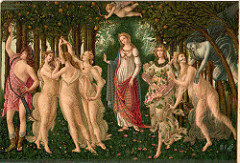
Botticelli
1482
Uffizi Gallery, Florence
tempera on panel
– Venus in the center, framed by the trees, looking at us
– allegorical representation of the season of Spring; Mercury pushing away the clouds (winter)
– over 100 different botanical species of flowers
– from left; Mercury, the Three Graces, Venus, Flora, Chloris, Zephyrus
– idealized figures, seem weightless

Piero della Francesca
1465-72
– Federico something, had battles scars on the right side of his face so had his left side painted

aka “Room of the Newlyweds”
Andrea Mantegna
1465-74
– oculus PAINTED ceiling
– example of how much Italians loved perspective

Michelangelo
1501-04
– High Italian Renaissance sculpture
– originally placed outside the town hall, but later moved inside
– heroism, confidence, élégance
– artistic perfection
– the moment right before victory ?

Leonardo da Vinci
1491-1508
National Gallery, London
oil on wood
– sfumato, softness
– pyramidal composition, calmness, grace, elegance
– holy characters painted on earth, “Madonna of Humility”
– Baby John the Baptist is already praying towards Baby Jesus

Leonardo da Vinci
1495-98
Santa Maria delle Grazie, Milan
fresco
– “one of you will betray me”
– orthogonals meet at Jesus’ head
– 12 apostles divided into 4 groups of 3, 6 on each side of the table, perfectly balanced
– Christ reaching to glass of wine and bread
– each reacting towards what Jesus said differently, but Jesus is calm and solemn
– windows in the back frame Jesus
– Renaissance idea of creating something eternal and beautiful out of the chaos of humanity
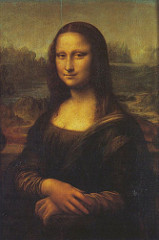
Leonardo da Vinci
1503-17
Louvre Museum, Paris
oil on wood
– Leonardo’s favorite painting, always carried it with him; died in Paris, so it ended up in the Lourve
– sfumato background
– where the eyebrows at?
– was stolen from the museum
– one of the first Italian portraits not done from the side

aka “Madonna del cardellino”
Raphael
1506
Galleria degli Uffizi, Florence
oil on wood
– calm scene, pyramidal composition, balanced
– Mary’s “throne” is a rock on the ground
– Baby Jesus standing contrapossto
– goldfinch is a symbol of the crucifixion b/c the red spot on it is said to come from a goldfinch that tried to take of a thorn off Jesus crown and a drop of blood landed on it
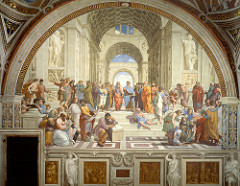
Raphael
1509-11
Stanza della Segnatura, Papal Palace, Vatican City
fresco
– Humanist dream team, all the great scientists, mathematicians, philosophers of Ancient Greece
– but Roman architecture, oops
– Plato on the left, pointing to heaven, spiritualism
– Aristotle on the right, hand over ground, empirical thinking
– Apollo on left, poetry; Athena on the right; war and wisdom
– celebration of human achievement
– big seating figure is Heraclitus, modeled after Michelangelo
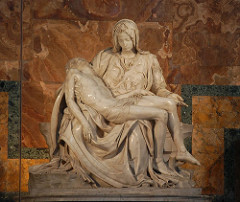
Michelangelo
1498-1500
Saint Peter’s Basilica, Rome
marble
– Mary is a giant
– Renaissance calmness
– intimate depiction
– grief, but not overly dramatic

Michelangelo
1508-12
Vatican City, Rome
– old testament stories, from book of Genesis
– Michelangelo-esque massiveness to figures, muscularity
– awesome
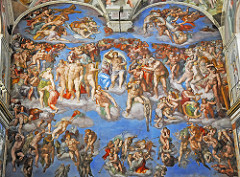
Michelangelo
1534-41
Vatican City, Rome
fresco
– about 25 years after the ceiling
– anger, fear, no longer High Renaissance optimism or gracefulness or calmness
– Christ is about to SMITE the damned
– St. Bartholomew, holding flayed skin (symbol of martyrdom), portrait of Michelangelo
– all the figures are super-muscular, Michelangelo style
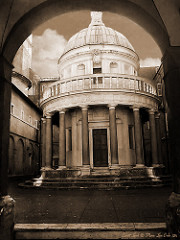
Donato Bramante
c. 1502
San Pietro in Montorio, Rome
– epitome of Renaissance architecture, balance, rationality, HARMONY, perfect geometry
– “little temple”
– marks site of crucifixion of St. Peter, “martyria”
– radial, circular, focus on center
– throwback to Ancient architecture
– Renaissance idea that man can create heavenly perfection on Earth, humanism
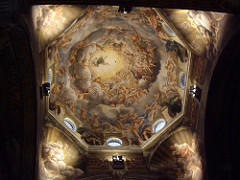
Correggio
1526-30- dizzying, so much movement
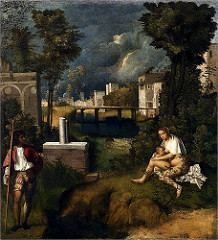
Giorgione
1506-1508
Accademia, Venice
– not a religious painting
– kind of mysterious about meaning; allegory, adamn and eve?
– storm is a’brewin, but the figures seem indifferent
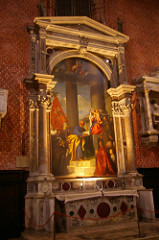
Titian
1519-26
Santa Maria Gloriosa dei Frari, Venice
oil on canvas
– Mary and Jesus placed off-center
– flag is the coat of arms of the Pesaro family, patrons of the painting, on the bottom right kneeling
– triangle hierarchies

Titian
1509
oil on wood
– naked, but they’re muses so it’s ok
– big influence on Manet’s Luncheon on the Grass

Titian
1538
Galleria degli Uffizi, Florence
oil on canvas
– NAKED, frontal, nudity was appropriate when disguised as something mythological/historical
– looking at us, confidence, eroticism, alluring
– sets the theme of the “reclining nude”
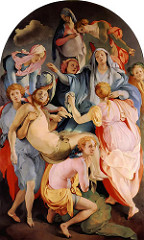
Pontormo
1525-28
oil on panel
– Mannerism, strangely shaped, over-the-top grief reaction, twisting bodies, elongated limbs, unnatural postures
– right next to fresco of the Annunciation
– entombment or deposition, stripped of symbolism
– no earthly setting, unlike contemporaries

Parmigianino
1530-33
Galleria degli Uffizi, Florence
– Mannerist, elongated body parts, tiny head, tiny toes, idealized
– Mary’s body frames Baby Jesus body
– Baby Jesus looks terminally ill
– throwback to Michelangelo’s Pieta, posture of baby Jesus and dead Jesus
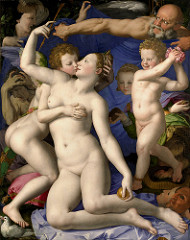
aka “Venus Cupid, Folly, and Time”
Bronzino
c. 1545
National Gallery, London
– uncomfortable to look at, disharmony, all over the place
– Venus, holding a golden apple and Cupid’s arrow, doves at Cupid’s feet another symbol of Venus
– Venus and Cupid kissing, erotic, incestousness
– pale, whiteness
– Cupid’s body “zig-zag”, really unnatural posture, uncomfortable to look at
– masks = “deception”
– little kid = “pleasure” “folly”
– little girl with body of serpent, legs of a lion, tail of a scorpion, holding honeycomb = “temptation”, other hand is twisting back really unnaturally, holding scorpion stinger
– Father Time, hourglass on his back, arm is bent really weird
– weird figrure on the top left, mask, oblivion?
– screaming figure = “syphillis”? the cost of pleasure?
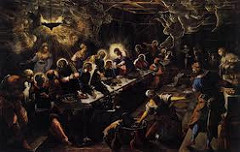
Tintoretto
1594
oil on canvas
– CHIAROSCURO, lots of shadows, contrasts
– Jesus emanates light, apostles also emanate light but not as much as Christ
– Mannerism b/c unbalanced, not frontal perspective, ASKEW, diagonal, busy scene
– Judas on the other side of the left
– wispy angel ghost things, translucent
– other people in the bottom right help humanize this very serious moment

Albrecht Dürer
1500
Alte Pinakothek, Munich
– Jesus doppelgänger, frontal pose, passive expression, long hair
– very serious portrait
– inscription about how he’s only 28 when he painted this, kinda braggy
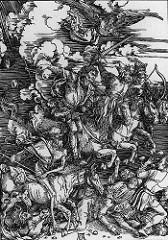
Albrecht Dürer
1498
woodcut
– mass-produced
– guy holding bow = Pestilence; guy holding sword = War; guy holding scales = Famine; 4th guy is Death
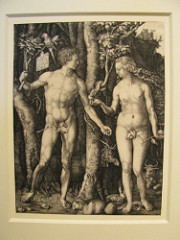
aka “The Fall of Man”
Albrecht Dürer
1504
engraving
– each animal is a symbol of a humor
– elk = “melancholy”
–

Albrecht Dürer
1526
Alte Pinakothek, Munich
oil on wood
– from left to right; John (open book), Peter (key), Mark (scroll), John (sword)
– diptych
– painted during Protestant Reformation and Dürer converted to Lutheranism; John, associated with Martin Luther, holding the bible; Peter, associated with the papacy, reading what John is pointing out
– larger-than-life figures, very powerful
– wasn’t commissioned, painted by Dürer for fun

Tilman Riemenschneider
1499-1505
– Judas in the middle
– brown, muted, wood, humble, earthly
– disproportionate bodies, bobble-heads
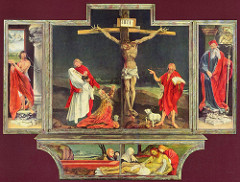
Mattias Grunewald
1510-1515
– originally in St. Anthony’s hopsital, specialised in St. Anthony’s Fire
– Jesus feet look putrid
– diptych opens on Jesus legs, reference to amputation?
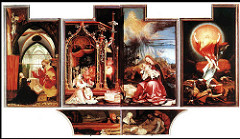
Mattias Grunewald
1510-1515
– roses, no thorns = “Virgin Mary”

Cranach the Elder
c. 1537
National Gallery of Art in Washington, DC
– she naked; not a religious painting, maybe meant as a private painting for alluring purposes
– Northern Renaissance painting of Italian Renaissance themes
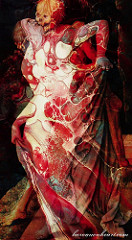
Baldung Grien
Offentliche Kunstsammlungen Basel
c. 1500
– student of Albrecht Durer
– negative view of female seduction
– look of pure disgust

Albrecht Altdorfer
1529
Alte Pinakothek, Munich
oil on panel
– a real battle that took place against the Ancient Greeks (Alexander the Great) and Persians (Darius III); Greece won, allowing them to expand their empire vastly
-West vs. East, Europe vs. Asia, Christianity vs. Islam, Night vs. Dark, Moon vs. Sun
– commissioned by the Duke of Bavaria, battling the Ottomans
– “world landscape” (i.e. banks of the Nile river aka Egypt), as if to imply that the winner takes all
– semi-bird’s eye view, very detailed, each soldier is individually painted
1513-1521
River Cher, France
– “Walt Disney” castle
– second most visited château in France after Versailles
– was handled by women for most of history; Katherine Briçonnet, Diane de Poitiers, Catherine de’ Medici, Madame Louise Dupin
– Catherine de’ Medici’s favorite hang out spot; super fancy parties, people dressed up as unicorns
– hosted France’s first fireworks show
– Italian Renaissance influence in orderliness and repetition
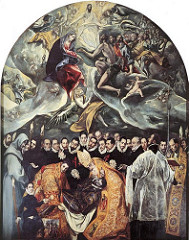
El Greco
1586
Santo Tomé, Toledo, Spain
oil on canvas
– Spanish Renaissance
– Byzantine style influence
– division between earthly (below) and heavenly (above) realm, supernatural space
– figures in heavenly sphere are elongated and seem to be made out of ectoplasm or some unnatural material
– legends says St. Stephen (left) and St. Augustine (right) descended from heaven to bury count Orgaz; grey wisp is his spirit being carried up to heaven
– modern-time Spanish noblemen, based on real portraits

Hieronymus Bosch
c. 1505-1515
Museo del Prado, Madrid
oil on oak
– triptych
– weird, imaginative, unusual, crazy
– alchemy?
– perverted, strawberries, “handstand sex”
– ephemeral earthly delights
– right panel is hell
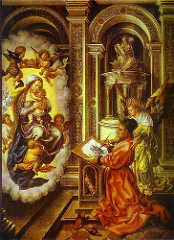
aka “St. Luke Painting the Madonna”
Jan Gossaert (aka Grossart)
c. 1515-25
Kunsthistorisches Museum, Vienna
– St. Luke’s eyes are half-closed, as if he is is being possessed by the angel
– over the top style, ostentatious
– baby Jesus got swole
– N. Renaissance, very detailed, lots of fabric folds, linear perspective isn’t perfect
– Moses grisaille, holding Ten Commandments tablet; division of painting into left and right, the heavenly and the earthly
– Gossaert, self-portrait?
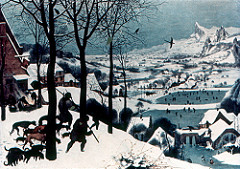
Pieter Bruegel the Elder
1565
Kunsthistorisches Museum in Vienna, Austria
oil on wood
– genre scene
– hunters and dogs retuning empty-handed
– Alps in background aren’t real
– dead trees in foreground
– peasants in background different winter activities
– series of paintings showing different months of the year (December/January)
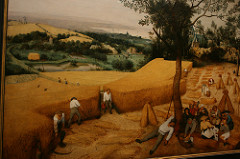
Pieter Bruegel the Elder
1565
Metropolitan Museum of Art, New York City
oil on wood
– peasants eating/harvesting food
– series of paintings showing different months of the year (August)
– calm genre scene
– Bruegel’s trademark deep foreground
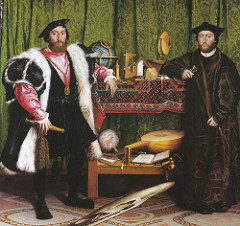
Hans Holbein the Younger
1533
National Gallery, London
oil on oak
– Memento Mori skull, reminder of death, ANAMORPHOSIS, can be seen at an angle
– they are in England, watching over King Henry the VIII, who is about to break away from the Roman Catholic church; lute has a snapped string, trouble in paradise, hymn book is opened to a hymn by Martin Luther (Reformation)
– guy on the left is the commissioner, big guy, dressed very grandly, holding a dagger, represents active personality, inscribed with his age (29)
– guy in the right is a bishop, dressed modestly, muted colors, elbow over a book, contemplative nature, age is 23
– top shelf of objects represents celestial sphere
– bottom shelf represents terrestrial sphere
– incredibly realistic
– contrast between earthly achievements and the “inevitability of death”
– relation between the angle of the lute and the skull
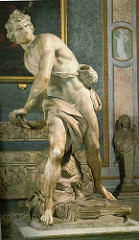
Bernini
1623
Galleria Borghese, Rome
marble
– Baroque, not High Renaissance anymore
– shows the moment before victory
– throwback to ancient antiquity Hellenistic sculpture in that it interacts with it’s space around it; not meant to be viewed only from the front
– unstable posture, not balanced; without any context it would appear as if he is about to fall over, implied sense of movement
– aggressiveness, furrowed brow, turmoil, tension, twisting

Bernini
1647-52
Cornaro Chapel, Santa Maria della Vittoria, Rome
– St. Theresa would have visions of an angel visiting her, angel penetrating St. with gold-tipped arrow
– eroticism, “pure bliss”, facial expression looks like an orgasm; strong emotional reaction
– lightness of sculpture, shapes marble to look and feel like floating clouds
– natural light entering from above
– brings the viewer into it by surrounding architecture; busts of patrons on the sides as if inside theater boxes
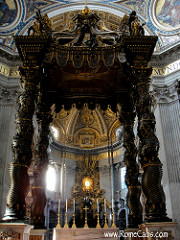
Bernini
1623-34
St. Peter’s Basilica, Vatican City
bronze
– commissioned by Pope Urban VII
– rumored to mark the spot of St. Peters tomb
– shapes bronze to look like fabric
– trademark Bernini’s spiral movement
– architecture + sculpture
– very tall, 66 feet, grandness, overwhelming
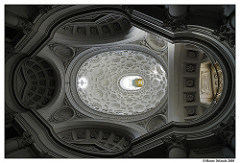
Borromini
1646
Rome, Italy
– commissioned by Pope Barberini
– BAROQUE, oval fetish
– natural light entering, adds to effect of weightlessness to the ceiling, also because it’s white
– it looks very complex but it’s all rationally thought and planned
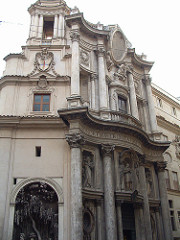
Borromini
1646
Rome, Italy
– commissioned by Pope Barberini
– undulating façade, curves, waves
– balance of convex and concave
Piero della Francesca
1448-50
– Dove= holy spirit
– Stillness of bodies
– Christ is in the center of the picture, contrapposto
– Verticals- trees& bodies





